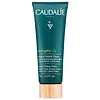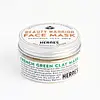What's inside
What's inside
 Key Ingredients
Key Ingredients

 Benefits
Benefits

 Concerns
Concerns

 Ingredients Side-by-side
Ingredients Side-by-side

Water
Skin ConditioningKaolin
AbrasiveBentonite
AbsorbentGlycerin
HumectantAcacia Senegal Gum
MaskingXanthan Gum
EmulsifyingBenzyl Alcohol
PerfumingAlcohol
AntimicrobialSodium Dehydroacetate
PreservativeCI 77491
Cosmetic ColorantCitrus Aurantium Bergamia Fruit Oil
MaskingVitis Vinifera Fruit Extract
Skin ConditioningLimonene
PerfumingLavandula Angustifolia Oil
MaskingLinalool
PerfumingSodium Citrate
BufferingCitric Acid
BufferingDehydroacetic Acid
PreservativeCoffea Arabica Seed Extract
MaskingCoffea Robusta Seed Extract
Skin ConditioningCarbomer
Emulsion StabilisingCupressus Sempervirens Oil
MaskingSalvia Sclarea Oil
MaskingCI 77499
Cosmetic ColorantCommiphora Myrrha Oil
MaskingSantalum Album Oil
MaskingAnthemis Nobilis Flower Oil
MaskingPapain
Skin ConditioningPetroselinum Crispum Seed Oil
Masking1,2-Hexanediol
Skin ConditioningCaprylyl Glycol
EmollientSodium Benzoate
MaskingLactic Acid
BufferingAlgin
MaskingPotassium Sorbate
PreservativeWater, Kaolin, Bentonite, Glycerin, Acacia Senegal Gum, Xanthan Gum, Benzyl Alcohol, Alcohol, Sodium Dehydroacetate, CI 77491, Citrus Aurantium Bergamia Fruit Oil, Vitis Vinifera Fruit Extract, Limonene, Lavandula Angustifolia Oil, Linalool, Sodium Citrate, Citric Acid, Dehydroacetic Acid, Coffea Arabica Seed Extract, Coffea Robusta Seed Extract, Carbomer, Cupressus Sempervirens Oil, Salvia Sclarea Oil, CI 77499, Commiphora Myrrha Oil, Santalum Album Oil, Anthemis Nobilis Flower Oil, Papain, Petroselinum Crispum Seed Oil, 1,2-Hexanediol, Caprylyl Glycol, Sodium Benzoate, Lactic Acid, Algin, Potassium Sorbate
 Reviews
Reviews

Ingredients Explained
These ingredients are found in both products.
Ingredients higher up in an ingredient list are typically present in a larger amount.
Kaolin is a clay. It is used for oil control and to help minimize pores. Like other clays, kaolin has the ability to absorb excess sebum or oil. This can help clean out pores and mattify the skin.
Some types of kaolin may have exfoliating properties. When water is added to kaolin, it becomes a paste with small abrasive particles.
Most kaolin is a white color, but may be pink/orange/red depending on where it comes from.
The name 'kaolin' comes from a Chinese village named 'Gaoling'. Kaolin clay comes from rocks rich in kaolinite. Kaolinite, the mineral, has a silicate layered structure. Kaolinite is formed from chemical weathering of aluminum siilicate minerals.
Besides skincare, kaolin is commonly used to make glossy paper, in ceramics, toothpaste, and as medicine to soothe stomach issues.
Learn more about Kaolin